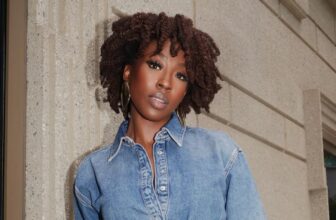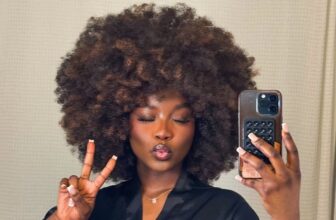Black women Are Now Turning To Minoxidil to Tackle Hair Loss
Hair is more than just a physical attribute for many Black women; it is a significant part of their identity and cultural heritage. Hair loss can therefore be particularly distressing, affecting self-esteem and emotional well-being.
Recently, more Black women have been turning to minoxidil, a medication traditionally used to treat male and female pattern baldness, to combat hair loss. This shift signifies a growing recognition of minoxidil’s potential benefits within the Black community.
On TikTok, Black women have shared over 25 million posts detailing their haircare journeys with minoxidil, often featuring striking before-and-after photos that reveal restored edges and covered bald spots. Unlike many other hair growth treatments targeting Black hair, minoxidil is praised for its scientific backing and verifiable outcomes.
According to @oohsojonesey, who used Minoxidil pills to grow out her edges, Minoxidil works pretty well for her hair growth. “This is your sign to use Minoxidil to get long baby hair. the user shared. “It has been working so well for me, and I’ve only used it for about a month on this specific area. I use the @cvs brand and the 5% foam.” Another user, @Chin8doll, said: “To the friend that put me on to Minoxidil, I love you forever 💗 #minoxidil #hairgrowth.” However, @blackhairstories added an important reminder: “Please research the cons prior to use,” highlighting the need to understand any medication, hair or beauty product before starting.
Ahead, are the reasons behind this trend, the efficacy and authenticity of minoxidil for Black hair, and the broader implications for safe haircare practices among Black women.
Understanding Hair Loss in Black Women
Hair loss, or alopecia, can have various causes, including genetics, hormonal changes, medical conditions, and external stressors such as hairstyles and treatments that cause trauma to the hair and scalp. Common types of hair loss in Black women include:
- Traction Alopecia: Often caused by hairstyles that pull tightly on the hair, such as braids, weaves, and ponytails.
- Central Centrifugal Cicatricial Alopecia (CCCA): A form of scarring alopecia that typically begins at the crown of the head and spreads outward.
- Alopecia Areata: An autoimmune condition that results in patchy hair loss.
- Telogen Effluvium: A temporary form of hair loss that usually follows a period of physical or emotional stress.
The Role of Minoxidil in Hair Loss Treatment
Minoxidil was discovered serendipitously during the development of a drug intended to treat high blood pressure. Initially, in the 1950s and 1960s, Upjohn (now part of Pfizer) was researching a class of drugs called vasodilators, which help widen blood vessels to reduce blood pressure. Researchers found it to be highly effective in treating severe hypertension when administered orally. It was marketed under the brand name Loniten.
During clinical trials and subsequent medical use, patients taking oral minoxidil began to report an unusual side effect: excessive hair growth, also known as hypertrichosis. This was observed not only on the scalp but also on other parts of the body. Recognizing the potential for a hair growth treatment, scientists explored the effects of applying minoxidil topically.
By the late 1970s, clinical trials for topical minoxidil as a treatment for androgenetic alopecia (male and female pattern baldness) were underway. In 1988, the U.S. Food and Drug Administration (FDA) approved topical minoxidil 2% solution for over-the-counter use in treating male pattern baldness. Later, in 1991, it was also approved for use in women. The approval of a 5% solution followed, providing a stronger option for more stubborn cases of hair loss.
While the exact mechanism by which minoxidil promotes hair growth is not fully understood, it is believed to work by:
- Increasing Blood Flow: Minoxidil is thought to dilate blood vessels in the scalp, increasing blood flow to hair follicles, which may help to revive shrunken hair follicles and extend their growth phase.
- Stimulating Follicles: It may directly stimulate hair follicles to shift from the resting phase (telogen) to the active growth phase (anagen), thereby promoting hair growth.
Why Black Women Are Turning to Minoxidil
As earlier mentioned, research and anecdotal evidence suggest that minoxidil can be effective in promoting hair growth and reducing hair loss, especially in Black women. Many have reported noticeable improvements in hair density and length after consistent use. Minoxidil is widely available over the counter in various formulations, making it a convenient option for those seeking to address hair loss without needing a prescription.
And, when compared to other hair loss treatments, such as prescription medications and hair transplant surgeries, minoxidil is relatively affordable, making it accessible to a broader population. Moreover, the increased awareness on social media about hair loss conditions and available treatments has led more Black women to explore minoxidil as a viable option.
Also, many Black women have found ways to incorporate minoxidil into their existing hair care routines without disrupting other practices, such as protective styling and natural hair care. For people like @adelebeauty, who is documenting her Minoxidil journey on TikTok, this claim is hard to deny. She has found a way to embrace her natural hair with the proper application of Minoxidil.
@adelebeauty2 ♬ original sound – adelebeauty2
Benefits of Minoxidil for Black Hair
While minoxidil has been shown to be effective for many users, its efficacy can vary based on individual factors such as the cause and extent of hair loss, consistency of use, and adherence to the treatment regimen. For Black women, specific considerations include:
- Black hair tends to be more fragile and prone to breakage. Minoxidil’s application should be done with care to avoid additional stress on the hair.
- Some users may experience scalp irritation, itching, or dryness. It’s important to monitor for these side effects and consult a healthcare professional if they occur.
- To see optimal results, minoxidil must be applied consistently, usually twice a day. This can be challenging for some users, but consistency is essential for success.
- Using minoxidil in conjunction with gentle hair care practices, such as avoiding tight hairstyles and using moisturizing products, can enhance its effectiveness.
@angela.onuoha Replying to @Yul Andile Sidman #trichologist #trichologyeducation #trichology #cosmeticchemiststudent #scalpspecialist #hairspecialist #scalpscience #hairscience #minoxidilresult #minoxidilhairregrowth #minoxidil #hairgrowthproducts ♬ original sound – Curlbellaa
Does minoxidil cause any side effects?
According to the TikTok video above, WTS Certified Trichologist Angela Onuoha says that while Minoxidil is effective for many people, it can also cause side effects, ranging from mild to severe. Common side effects include scalp irritation like redness, itching, dryness, or flaking, especially for those with sensitive skin.
Some women may experience unwanted facial hair growth if the solution drips onto the forehead or is applied too close to the hairline. Also, an initial increase in hair shedding may occur as hair follicles move from the resting phase to the growth phase, but this usually stops after a few weeks.
Less common side effects include allergic reactions, which can cause a rash, hives, or swelling, particularly those sensitive to the solution’s ingredients. Some users might also notice changes in their hair’s texture or color, though this is rare.
In rare cases, more serious side effects can occur. Minoxidil can cause heart palpitations or changes in heart rate, requiring immediate medical attention. Some users might feel dizzy or lightheaded, especially those with underlying heart conditions. Swelling in the hands, feet, or face can indicate fluid retention or other cardiovascular issues, and severe chest pain, though rare, needs urgent medical care.
To use minoxidil safely, it’s a good idea to do a patch test first by applying a small amount to a limited area of the scalp to check for any bad reactions. Avoid applying minoxidil to areas other than the scalp to prevent unwanted hair growth elsewhere. Follow the dosage instructions carefully, usually twice daily, to minimize side effects. If you have a history of heart disease, high blood pressure, or other significant health issues, consult a doctor before using minoxidil.
Other Holistic Health Approaches for Tackling Hair Loss
Taking a holistic approach to tackle hair loss means looking at the whole picture of your health. Start with eating a balanced diet rich in protein, iron, vitamins, and minerals from fruits, vegetables, lean meats, and nuts.
Managing stress through exercise, mindfulness, and getting enough sleep is also important because stress can contribute to hair loss. Taking care of your scalp by massaging it regularly, using gentle products, and keeping it clean helps promote healthy hair growth.
You can also try natural remedies like aloe vera, coconut oil, and onion juice, which have been shown to support hair health. Certain herbs and supplements like saw palmetto, ginseng, and biotin can be beneficial as well. Drink plenty of water to stay hydrated, and don’t forget to see your healthcare provider regularly to check for any underlying health issues that could be causing hair loss.
By combining these practices, you can take a comprehensive approach to managing hair loss and promoting healthier hair growth.
Photo: Suad Kamardeen/Unsplash
You May Also Like:
15 Chic Braided Bob Hairstyles to Try for a Confident Look
December 23, 20255 Ways Honey Can Transform Your Hair Routine Naturally
December 22, 202515 Festive Holiday Hairstyle Ideas That Will See You Through The Season
December 10, 2025How to Maintain Natural Hair Moisture During The Festive Season
December 9, 2025Kim Kardashian Expands Skims Into Hair Care With New Tangle Teezer and Slip Collabs
December 2, 2025How To Protect Your Natural Hair Under Wigs
December 1, 2025Pixie Cut Fever: Every Black Woman Suddenly Wants the Big Chop
November 5, 2025The Best Hairstyles for Women Over 50, According to Real Women
November 3, 2025Cardi B Says She Hasn't Washed Her Hair in 3 Months and Fans Does Not Like It
October 31, 202520 Sew-In Hairstyles So Gorgeous You’d Want to Screenshot
October 30, 2025Is 2025 The End of the Natural Hair Movement?
October 23, 2025Miley Cyrus Debut a Short Curly Blonde Hair and It's Cute
October 21, 2025





